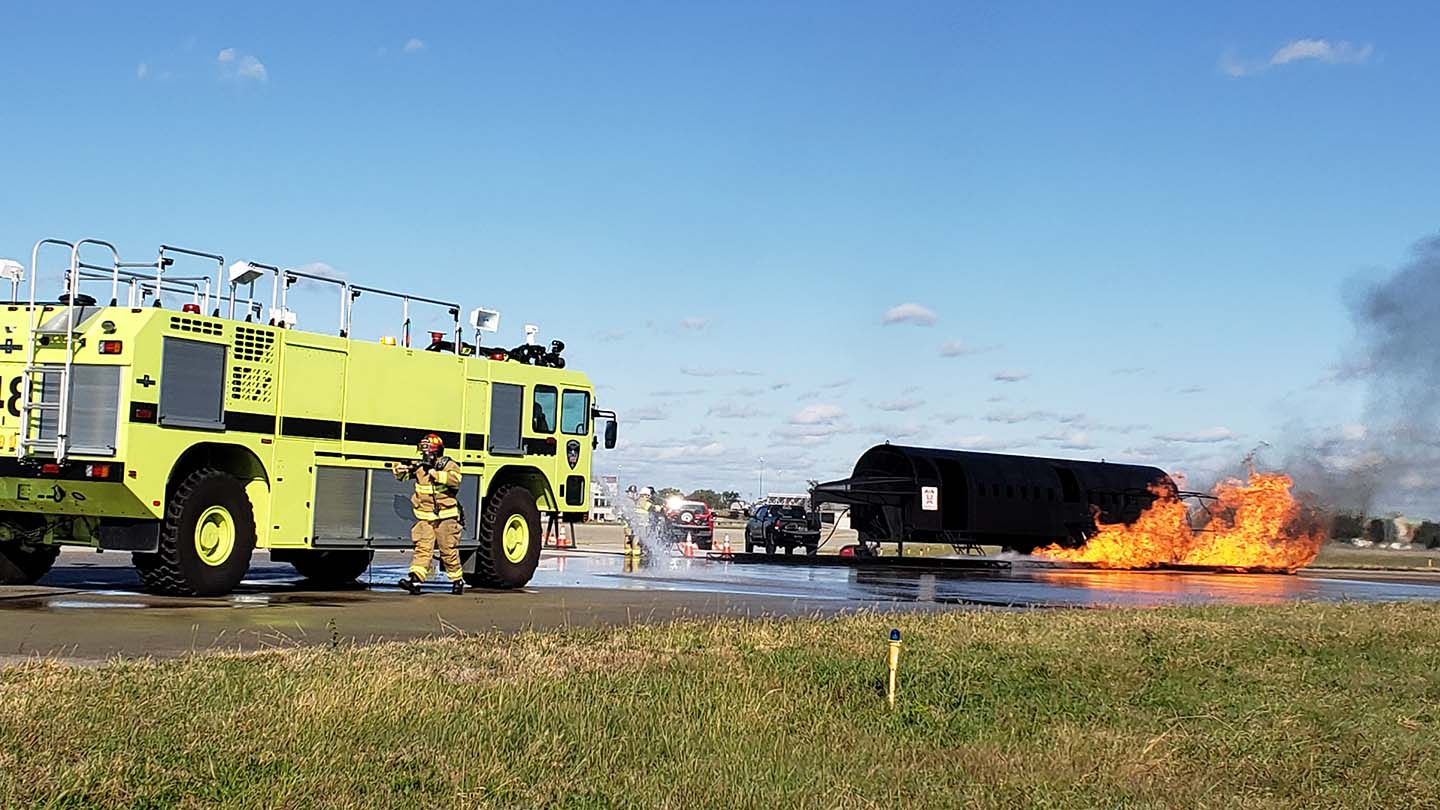Planning for safety and emergency response at airports is a core responsibility that requires clear structure and coordination.
An Airport Emergency Plan (AEP) is designed to address a wide range of emergency scenarios, forming the backbone of effective airport crisis management and airport emergency communications.
A well-executed AEP equips airport personnel, stakeholders, and emergency responders with the steps to take during critical situations and reduce harm and restore operations.
This article explores the importance of AEPs, what they include, and actionable strategies to develop and enhance emergency preparedness in airports.
What is an Airport Emergency Plan?
An AEP is a structured document that outlines the steps and responsibilities involved in managing emergencies. These events may include aircraft incidents up to the largest aircraft with operations at the airport, as well as natural disasters, bomb threats, hazardous spills, or large evacuations.
The plan is designed to reduce the impact of emergencies through defined roles, coordinated actions, and clear communication. It must meet the requirements of the Federal Aviation Administration (FAA) Title 14 Code of Federal Regulations (CFR) Part 139.325, which sets the standards for emergency planning at airports.
When responsibilities are clearly assigned and potential risks are addressed in advance, airport operations are more likely to continue under pressure.
All airports certified by the FAA under 14 CFR Part 139 (Part 139) are required to have an AEP approved by the FAA as part of the airport’s annual certification inspection. Airports of all sizes, including those not required under Part 139, can depend on an AEP to maintain stability during a crisis.
Why an Airport Emergency Plan Matters

Airports operate in complex environments where disruptions can escalate quickly.
A well-developed Airport Emergency Plan supports continuity and safety in several key areas:
- Regulatory Compliance: FAA regulations require airports with Part 139 operating certificates to maintain an emergency plan. Failing to comply can result in penalties or suspension of operations.
- Coordinated Response: A clear plan helps airport staff, emergency responders, airlines, and local agencies work together without confusion.
- Risk Reduction: Preparing for likely scenarios can lower the chance of injury, property damage, or extended downtime.
- Clear Communication: AEPs define how information should flow during an emergency, preventing delays or missteps.
- Faster Recovery: With step-by-step procedures in place, airports can return to normal operations more efficiently after a crisis.
AEPs should be updated regularly using feedback from real incidents, training drills, and After-Action Reports.
What Should Be Included in an Airport Emergency Plan?
An Airport Emergency Plan must account for a range of potential emergencies and provide clear instructions for each group involved in a response.
According to FAA regulations under Title 14 CFR Part 139.325, certain elements are required in all certified airport plans. For more detailed information, refer to the Advisory Council’s updated guidance for AEPs here.
Overview and Structure
Every AEP begins with the Basic Plan that defines its overall purpose, scope, and objectives.
Part 139 requires the following sections in the Basic Plan:
- Introduction
- Introductory Information
- Purpose
- Situation and Assumptions
- Operations
- Organization and Assignment of Responsibilities
- Administration and Logistics
- Plan Development and Maintenance
- Authorities and References
This sets the framework for how the airport will approach emergency situations.
It also outlines the command structure, including the roles and responsibilities of airport personnel, responders, and supporting agencies. The Basic Plan is meant to address assumptions about likely hazards based on the airport’s location, size, and operations.
Types of Airport Emergencies Covered
The AEP must specify the types of incidents it is designed to handle.
According to federal rules, these commonly include:
- Bomb incidents, including designation of parking areas for the aircraft involved
- Structural fires
- Fires at fuel farms or fuel storage areas
- Natural disasters
- Hazardous materials/dangerous goods incidents
- Sabotage, hijack incidents, and other unlawful interferences with operations
- Failure of power for movement area lighting
If the airport is located near a body of water, the plan must also include procedures for water rescues involving aircraft.
Functional Annexes
Functional annexes provide more detailed guidance for carrying out specific tasks during an emergency. These include coordination of medical services, communication methods during a crisis, crowd management strategies, and the removal of disabled aircraft.
Each section describes how resources will be activated, how information will be shared, and who is responsible for each action. Every annex must also be structured with the same general items listed in the Basic Plan.
The annexes required by the FAA are:
- Command and Control
- Communications
- Alert Notification and Warning
- Emergency Public Information
- Protective Actions
- Law Enforcement/Security
- Firefighting and Rescue
- Health and Medical
- Resource Management
- Airport Operations and Maintenance
Coordinate with Agencies and Stakeholders
The AEP must outline how the airport will work with external partners. These typically include fire departments, law enforcement, emergency medical services, airlines, the Transportation Security Administration (TSA), and local or regional government agencies.
Involving these groups in the planning process sets consistent expectations and promotes a more unified response when emergencies occur, improving emergency communications.
Training and Exercise Drills
Federal standards require regular training to keep the plan actionable. For Part 139 airports, full-scale emergency exercises must be conducted every 36 months.
These exercises test the plan’s effectiveness and help identify areas for improvement. In addition to full exercises, airports often conduct tabletop sessions or partial drills to keep personnel familiar with their roles.
AEP Maintenance
The FAA requires that AEPs be reviewed at least once every 12 consecutive calendar months. A tabletop exercise is held at most airports as a part of the review process. This annual review helps the plan reflect current conditions, including updates in staffing, operational procedures, infrastructure, and local risk factors.
Regular maintenance keeps the document compliant with FAA regulations and ensures that all involved parties are working from accurate, up-to-date information when a real emergency occurs.
Enhancing Your Airport Emergency Plan

Refining an Airport Emergency Plan often involves resolving planning gaps and keeping the document aligned with current risks and procedures.
The following approaches can strengthen the plan and allow for smoother coordination across airport operations:
Conduct a Gap Analysis
A gap analysis allows airports to compare the current version of their AEP against daily operations and federal requirements.
This comparison can highlight where updates are needed, such as adding new sections related to cybersecurity or drone/UAP-related incidents, which may not have been addressed in older plans.
Leverage After-Action Reports
A careful review of emergency responses and training exercises is a key part of refining an AEP.
After-Action Reports document what occurred, what went according to plan, and where breakdowns occurred. These often include structured After-Action Reviews, where participants walk through the event to assess decisions, timing, and coordination in real time.
When completed consistently and reviewed during scheduled updates, these tools help airports make focused adjustments that reflect actual performance and improve their crisis management.
Focus on Airport Communication Systems
Effective airport emergency communication is important during any crisis. The plan should include backup methods in case of equipment failure.
Implementing interoperable communication tools provides easier coordination among all stakeholders during a crisis. Best practices include maintaining redundant communication channels and integrating systems across agencies to enhance situational awareness and response efficiency.
Many airports now use tools that link voice, radio, and digital messages across teams to reduce confusion during time-sensitive events.
Develop Appendices or Standalone Plans for Unique Airport Hazards
Some airports face conditions that fall outside of standard emergency types. These might include nearby chemical facilities, wildfire zones, or flight paths over large bodies of water.
Creating separate documents for these issues allows teams to respond with more clarity and focus when something unexpected happens. Each hazard-specific appendix should also include detailed standard operating procedures (SOPs), and comprehensive checklists tailored to the specific hazard.
Involve Stakeholders at Each Step
Airport staff, first responders, airlines, and security agencies all play a role in emergency planning. Their involvement from the early stages of drafting to testing builds clarity around roles and expectations. This kind of participation also highlights operational details that may otherwise be overlooked.
A Continuity of Operations Plan (COOP) or similar guidance should be included to outline how daily functions can continue during long disruptions.
Adopt Technology for Real-Time Updates
Digital platforms, especially those with shared access, can make it easier to keep AEPs current.
When updates are made in one place, all users with access see the same version, which reduces errors or outdated instructions during a response.
Common Challenges in Airport Emergency Plans
Even well-developed Airport Emergency Plans can run into recurring challenges that affect implementation and response.
A growing challenge is the shift from operations-led emergency planning to more formal emergency management (EM) programs. EM professionals, often coming from non-aviation backgrounds, may struggle to align with airport-specific operational needs. This can lead to tension between operations and EM teams over control and approach to the AEP.
Another common challenge is the limited resources available, particularly at smaller or non-hub airports. Budget and staffing constraints may limit how often a plan is updated or make it harder to conduct full-scale emergency exercises. While the FAA requires certain minimum standards under 14 CFR Part 139.325, implementation can vary depending on airport size and funding.
Breakdowns in coordination between emergency stakeholders may also affect the execution of an airport crisis management plan. Differences in agency protocols, airport emergency communication systems, or outdated contact lists can prevent a unified response. The FAA stresses the importance of joint planning and multi-agency drills to improve interagency coordination in Chapter 4, Section 4.3.
Many plans are overly lengthy, text-heavy, and outdated, making them difficult to navigate during real-time emergencies. If the AEP is not reviewed regularly, it may contain inaccurate details about personnel, infrastructure, or emergency contacts.
FAA guidance calls for an annual review of the AEP to keep it aligned with current operations, as shown in Chapter 5, Section 5.9.
Benefits of Regular Airport Emergency Plan Updates
AEPs require consistent review to reflect changing conditions, risks, and procedures.
Below are the benefits of regular plan updates to bolster an effective airport crisis management strategy:
- Addressing New Hazards: Revisions allow airports to add procedures for emerging issues like drone activity, cybersecurity incidents, or public health risks that may not have existed when the first airport crisis management plan was developed.
- Keeping Personnel and Partners Informed: Updates allow airport staff and outside agencies to stay current with their responsibilities, especially when roles shift or personnel change.
- Meeting Evolving Requirements and Regulations: Regular updates maintain compliance with FAA regulations and industry standards, while encouraging clearer airport emergency communication during a real event.
The Future of Airport Emergency Planning

As airport systems grow more interconnected and operational demands increase, emergency plans will need to adapt in both structure and scope.
One area of development involves the use of digital tools that support faster decision-making and improve situational awareness during a crisis. The FAA is exploring predictive analytics and real-time monitoring systems to detect disruptions early.
Cybersecurity has also become a more prominent focus. With many airport operations depending on digital platforms, emergency planning now extends to protecting systems from cyber incidents that could interfere with airport emergency communications, navigation, or facility access.
In addition, some airports are beginning to align their emergency planning practices with international guidelines. This provides consistency across borders and prepares teams for coordination with global partners during large-scale or multi-jurisdictional events.
While these trends point to more advanced capabilities in the future, the reliability of any new tool or method depends on the strength and clarity of the plan already in place.
Strengthen Your Airport Emergency Plan
An Airport Emergency Plan serves as a guide for coordinating response efforts, meeting regulatory standards, and supporting public safety. When updated regularly and based on actual experience, the plan becomes a tool that allows airport staff to respond with clarity and consistency, even in complex or unfamiliar situations.
Ready to enhance your AEP or improve airport crisis management and communication? Tidal Basin offers customized solutions to help airports build emergency plans that meet compliance standards and prioritize safety.
Contact our team today to ensure your AEP is equipped to handle future challenges.



